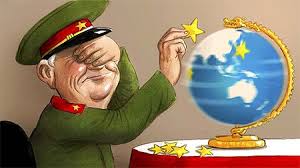
After the India China border clash, now China has claimed half of the area of a new victim – Tajikistan, the smallest Central Asian country. As per the recent reports, China has claimed the Pamir region of Tajikistan that accounts for 45 per cent of Tajik territory. In line with its modus operandi to stake a claim on foreign territories, Beijing has started with historical revisionism.
Daily Current Affairs Quiz 2020
Key-Points
China shares international borders with 14 sovereign states.
In addition, there is a 30-kilometre (19 mi) border with the special administrative region of Hong Kong, which was a British dependency before 1997, and a 3-kilometre (1.9 mi) border with Macau, a Portuguese territory until 1999.
With a land border of 22,117 kilometres (13,743 mi) in total it also has the longest land border of any country.
Disputed Areas of China
India-China border row: China has illegally occupied a 38,000 sq km of India’s land in Aksai Chin. In the Eastern sector, China also claims approximately 90,000 square kilometers of Indian Territory in the state of Arunachal Pradesh.
Nepal-China border dispute: China is also being accused of encroaching upon the territory of Nepal. Three members of the Nepali Congress moved a resolution in the House of Representatives – the Lower Chamber of the Nepalese Parliament – asking the Oli government to restore the country’s territory, which had been encroached upon by China.
China-Bhutan border row: In July 2017, senior Bhutanese officials spoke up against Chinese encroachments along the border and asked China to respect the procedure for border settlement that it had itself agreed on with Bhutan.
Eastern China Sea: China has Exclusive Economic Zone disputes with North Korea, South Korea, and Japan in the Yellow Sea (North Korea/South Korea) and East China Sea (South Korea/Japan). The details are given below:
Vietnam: China has occupied the Paracel Islands since 1974 when its troops seized a South Vietnamese garrison occupying the western islands. China built a military installation on Woody Island with an airfield and artificial harbor. Taiwan and Vietnam also claim their right over the islands.
Japan: The China-Japan dispute is over a group of uninhabited islands that fall in the Eastern China Sea and is named as the Senkaku Islands by Japan and the Diaoyu Islands by China. The Islands have been under Japan’s control since the 1890s, however in the 1970s, when the evidence of oil reserves came to fore, China expressed its claim over the islands.
Taiwan: China claims its right over Taiwan, but disputes are mainly over Macclesfield Bank, Paracel Islands, Scarborough Shoal, parts of the South China Sea, and the Spratly Islands. The Paracel Islands, also known as the Xisha Islands in Vietnamese, is a group of islands in the South China Sea whose sovereignty is claimed by China, Taiwan, Vietnam, and Myanmar (Burma).
Philippines: Parts of the South China Sea are contested between the two countries. The Philippines took this to the International Court of Justice, where they won the case but China did not abide by the ICJ order.
North Korea: Baekdu Mountain and Jiandao are bone of contention between the two nations. China has also claimed its right over all of North Korea on historical grounds (Yuan Dynasty, 1271-1368).
Russia: Despite signing several agreements, China unilaterally claims 160,000 square kilometers territory of Russia. Russians are increasingly apprehensive of encroachment from contiguous China into Far East Russia which is resource-rich, but sparsely populated, according to people familiar with the dynamics of Sino-Russian ties.
Singapore: Parts of the South China Sea are contested by both countries.
South Korea: Parts of the East China Sea is the reason behind the dispute. China has also claimed all of South Korea on historical grounds (Yuan Dynasty, 1271-1368).
Laos: China also claims its right over a large part of Laos on historical precedents (China’s Yuan Dynasty, 1271-1368).
Tajikistan: Chinese claims over Tajikistan territory is based on historical precedent (Qing Dynasty, 1644-1912).
Cambodia: China has, on occasion, claimed parts of Cambodia on historical precedent (China’s Ming Dynasty, 1368-1644).
Mongolia: China claims all of Mongolia on historical precedent (Yuan Dynasty, 1271-1368). In fact, Mongolia, under Genghis Khan, occupied China.
Tibet: Buddhist nation Tibet was an independent country during 1913 and 1950. The Chinese army invaded Tibet’s eastern borders and captured it in 1950. China also claims that Tibet has been an inalienable part of China since the 13th century under the Yuan dynasty.





